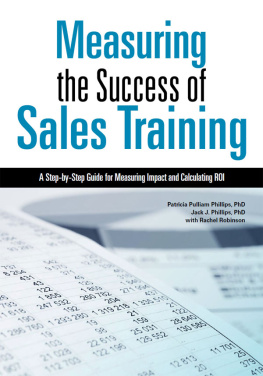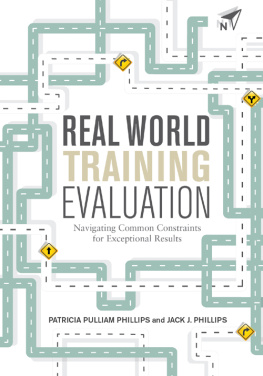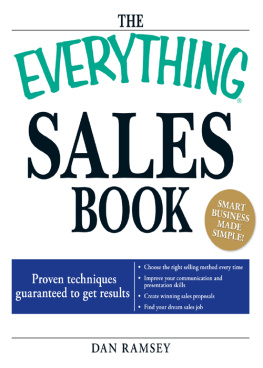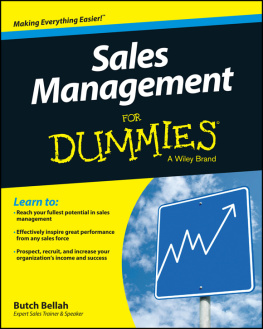2013 American Society for Training & Development (ASTD)
All rights reserved.
No part of this publication may be reproduced, distributed, or transmitted in any form or by any means, including photocopying, recording, or other electronic or mechanical methods, without the prior written permission of the publisher, except in the case of brief quotations
embodied in critical reviews and certain other noncommercial uses permitted by copyright law. For permission requests, please go to www.copyright.com, or contact Copyright Clearance Center (CCC), 222 Rosewood Drive, Danvers, MA 01923 (telephone 978.750.8400; fax: 978.646.8600).
ASTD Press is an internationally renowned source of insightful and practical information on workplace learning, performance, and professional development.
ASTD Press
1640 King Street Box 1443
Alexandria, VA 22313-1443 USA
Ordering information for the print edition: Books published by ASTD Press can be purchased by visiting ASTDs website at store.astd.org or by calling 800.628.2783 or 703.683.8100.
Library of Congress Control Number: 2012940627
ISBN-10: 1-56286-859-4
ISNB-13: 978-1-56286-859-8
e-ISBN: 978-60728-523-6
ASTD Press Editorial Staff:
Director: Glenn Saltzman
Manager and Editor, ASTD Press: Ashley McDonald
Community of Practice Manager, Sales Enablement: Mike Galvin
Editorial Assistant: Sarah Cough
Text and Cover Design: Ana Ilieva Foreman
Table of Contents
With ASTDs investment in selling skills, it has never been more important to show examples of sales skills at work. The process to evaluate these skills is sometimes perceived as straightforward and routine, simply a matter of tracking the sales gains after the program has been conducted. Credibly evaluating sales training programs is a bit more involved than that. Four important issues often surface when developing a credible study. First, since many other factors influence sales, there must always be a step to isolate the effects of the sales training program on the salesan omission in most studies. Second, when converting sales data to monetary values, only the profit margins of increased sales must be used, not the sales themselvesa mistake made by many. Third, the stream of monetary benefits for the increased profits must be conservative, usually representing only one year. Finally, the assumptions surrounding which costs to use in the ROI analysis are usually incomplete, inconsistent, and not conservative.
Sponsors need a credible, conservative approach to measuring ROIone that meets these four challenges. Using the ROI Methodology, all of the case studies in this book will address these issues, providing examples and benchmarks for others to use to evaluate these important types of programs.
In our visits around the world each year, we have been impressed with the work with ROI outside the United States. We have also noticed that the issues involved in creating, developing, and sustaining a comprehensive evaluation system are very similar from one country to another. In other words, evaluation is a universal language.
This publication includes eight case studies from around the world that were developed to show the value of sales training initiatives in various functions. The authors of these case studies are diligently pursuing accountability in sales training programs. Through their writing, they share their experiences with a process that continues to be at the forefront of measurement and evaluation.
TARGET AUDIENCE
These case studies will be ideal for anyone involved in the design, development, implementation, facilitation, or support of sales training and development programs. These studies show how these programs can be evaluated, pinpointing specific success factors along the way. A secondary audience is the executives who need to know how this important investment is evaluated. This includes sales managers and vice presidents of sales and marketing who are always concerned about the success of training, development, meetings, and events. Finally, a third audience is professors and students in sales programs where there is a need to show the value of training and developing the sales team.
THE CASES
Most selected case studies have adhered to the standards supporting the ROI Methodology. Some have neglected to adhere to the standards, noting lessons learned by not doing so. We are pleased with the studies presented in this volume and believe that those who have followed the progress of ROI use would agree that these are the best to be published in the sales training arena.
Although there was some attempt to structure cases similarly, they are not identical in style and content. It is important for the reader to experience the case studies as they were developed to identify the issues pertinent to each particular setting and situation. The result is a variety of presentations with a variety of styles. Some cases are brief and to the point, outlining precisely what happened and what was achieved. Others provide more detailed background information, including how the need for the program was determined, the personalities involved, and how their backgrounds and biases created a unique situation. In addition, while all case studies have been translated into English, we have tried to leave the nuances of the various languages and cultures intact.
In some cases, the name of the organization is identified, as are the individuals who were involved. In others, the organizations name is disguised at the request of either the organization or the case author. In todays competitive world and in situations where there is an attempt to explore new territory, it is understandable why an organization would choose not to be identified. Identification should not be a critical issue, however.
CASE AUTHORS
It would be difficult to find a more varied and impressive group of contributors than those providing case studies for this volume. The authors presented in this book are experienced and knowledgeable, and represent the highest standard of professionalism. Collectively, they represent practitioners, consultants, researchers, and even students. Many have already made a local or global mark in sales and marketing, measurement and evaluation, or both. All of them are or will be highly successful in their field.
SUGGESTIONS
We welcome your input. If you have ideas or recommendations regarding presentation, case selection, or case quality, please send them to us at ROI Institute, Inc., P.O. Box 380637, Birmingham, AL 35238-0637, or send them via email to .
ACKNOWLEDGMENTS
Although this casebook is a collective work of many individuals, the first acknowledgment must go to all the case authors. They are appreciated not only for their commitment to developing their case studies, but also for their interest in furthering the development and implementation of ROI evaluation in their organizations. We also want to acknowledge the organizations that have allowed us to use their names and programs for publication. We realize this action is not without risk. We trust the final product has portrayed them as progressive organizations interested in results and willing to try new processes and techniques.
We would also like to thank Mike Galvin and the rest of the publishing team at ASTD Press. We have enjoyed publishing more than 40 books with ASTD and look forward to many more in the future.











